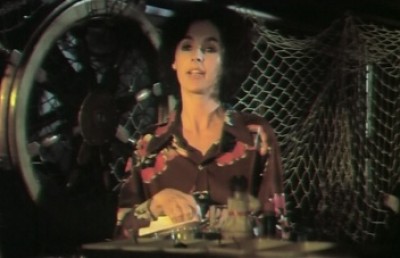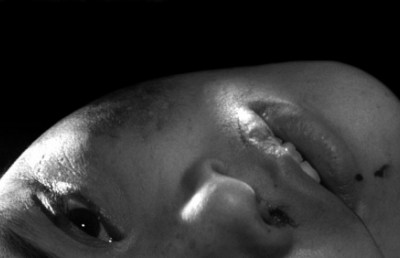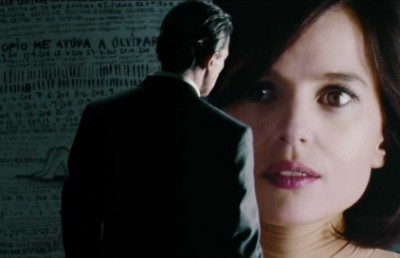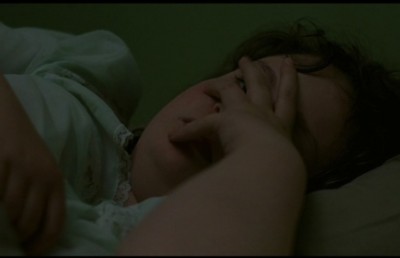Abject Anatomy: Catherine Breillat’s Anatomy of Hell
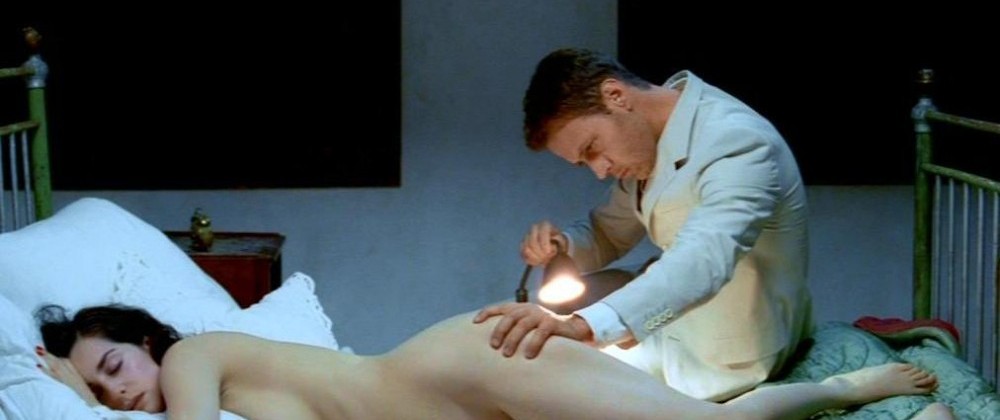
“Then you switch some lights on, to see her. Her. See what you’ve never seen before, the hidden sex, that which swallows up and holds without seeming to. See it like this, closed up around its own sleep .” 1
Marguerite Duras
“Je pense qu’il faut se confronter à la sexualité humaine et à nos peurs, nos interdits et nos émotions. Nos émotions soi-disant aussi basées sur l’interdit . . .” 2
Catherine Breillat
One of the fundamental concerns in feminist critiques of film is the presentation of the female body. Presentation can refer to many things. It can be used to describe how the body is positioned in regards to other characters, or how it is clothed. Sometimes it can even refer to the ways in which a woman’s body is exhibited in a revealing way. Feminist film theory examines how these techniques are used, and to what effect. Research in this field has helped to inform and inspire a counter-cinema that challenges the patriarchy by subverting the codes of traditional narrative cinema. This can be subtle, but in some cases it can also be extreme. Part of being provocative is provoking people, and over the years there have been a number of filmmakers who have broken through the boundaries of traditional representation and challenged the status quo by means of transgression. Catherine Breillat is one of these directors.
Breillat’s oeuvre is filled with films that have courted controversy, so seeking to confront the audience is not exactly new territory for the French filmmaker. In the case of Anatomie de l’enfer (2004), Breillat makes a very conscious decision to use explicit sexual imagery in order to push harder than ever against the boundaries of what society considers obscene. She unflinchingly presents the audience with images of the sort that are seldom seen outside of hardcore pornography, and by bringing these images to the screen Breillat presents female nudity in ways that challenge the spectators, rather than titillating them.
In the 1970s, Laura Mulvey suggested that we should consider the “destruction of pleasure as a radical weapon,” 3 and it should be obvious that Breillat’s approach echoes the strategies put forth by Mulvey in her writing. In particular, the uncomfortably graphic nature of certain sequences in the film demonstrates that Breillat is “daring to break with normal pleasurable expectations in order to conceive a new language of desire.” 4 An analysis of the way the body is presented in the film shows that if the gratuitous presentation of female nudity that is more commonplace in narrative cinema is often viewed as being objectification, then the way that Breillat gets close enough to examine the fluids secreted by the human body can be considered to be an abjectification. Throughout Anatomie de l’enfer , the spectator is inundated with images that focus on details that would normally be thought of as unsightly. There is clearly a voyeurism at work, but this practice of constantly presenting the audience with the sort of details that detract from the fantasy is a tool that, through its use, Breillat systematically attacks the carefully composed illusions of erotic spectacle that audiences are more accustomed to seeing.
An example of this occurs during the first night the protagonists spend at the Woman’s house by the sea. As she undresses, we see the red marks left on her body by the constriction of her bra. We watch as the Woman strips herself naked and displays herself on the bed. Her poses resemble any number of Renaissance nudes, but they differ in that there is a self-conscious nature to them. In this instance, the posed model has a voice. She is presented as a person, not an object, and is allowed to speak. The Man glares down at her exposed body under the harsh light of a bedside lamp. There are no shadows that would allow her to hide from this humiliating intrusion into her privacy. Suddenly, she asks whether or not she should have shaved her armpits. The Man declares that such an exercise is futile. He explains that this act is just one of the attempts that women make in order to conceal the obscenity that is a part of their nature, and states that the shaved parts of her body would simply take on an equally disgusting aspect; they would resemble the skin of a plucked chicken.
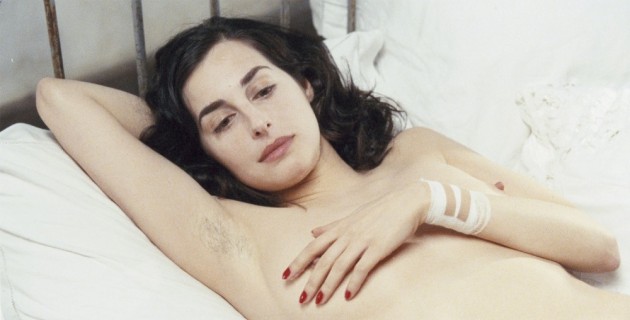
Amira Casar
It is relevant to note that in constructing the film, Breillat has declined to assign any names to her characters. They remain anonymous, much like the ‘You’ and ‘She’ we find in Marguerite’s 1982 novella The Malady of Death . The antonomasia of referring to the protagonists of Anatomie de l’enfer on the basis of gender alone connects with the idea that the film, while it does tell a story, is also an essay on attitudes and conventions wherein she is the Woman and he is the Man. Alison Butler writes that “in linear narrative, ‘Woman’ operates conventionally to signify an enigma, obstacle or prize for a male protagonist.” 5 The absolute lack of a conventional identity for the characters that Breillat is presenting to us has such a transparency to it that it affords the audience to see the ways in which the Woman substitutes for any woman, and the Man could very easily be any man. Aside from two brief childhood flashbacks, we see the two of them without any history. They have only these moments. There is no context. It is only their actions and their words during their time together which reveal anything about them.
As little as we may know about these characters, their actions do reveal a lot about their responses to what is going on between them. When the Man cries at the end of the first night, it is because he is deeply troubled by the degree to which the Woman’s desire to be pushed to her own limits is forcing him to the very edge of what he feels he is capable of doing. The Woman tries to comfort him by telling him that things have just begun. She wants to reassure him that it is only the beginning. She wants him to know that perfection wasn’t expected right from the start, and that things will get better as their time together progresses.
It is hard to say whether things ever do get easier for him. He stalwartly resists developing an attachment to the Woman, but throughout the nights that he visits her at the seaside home, it is a constant struggle for him. He is affected by what transpires, and to make things worse, his conflicts don’t end when the arrangement does. We see the Man drinking in a bar after his four nights with the Woman have elapsed. He is visibly shaken by his experiences and in a drunken state tells the patron beside him about what he has done, and the degree to which the Woman debased herself. He goes on to say that he was incapable of breaking her spirit. What he finds most startling is her strength of will. It is shocking to him that none of the unspeakable acts he committed was able to take her beyond the areas that she was willing to explore.
In contrast to the feelings that the Man displays, we rarely see the Woman show any emotion. Even during her suicide attempt at the beginning of the film, she maintains a calm and calculating demeanour. The only time that the Woman really lets her guard down is toward the end of the third night that the Man spends at her place. She demonstrates the insertion of a tampon, and explains the mechanism involved. During this display, she reveals her thoughts about the invention of the tampon. She tells him that it must have been designed by a man who hated women. Her opinion is that this infernal device must have been the creation of someone so disgusted by female genitalia that the applicator was designed so that it could be inserted without someone having to sully their digits by making direct contact with a vagina made impure by the flow of blood. At the end of her monologue she cries, and then asks the Man if she has lost all dignity because of this show of emotion.
For her, this moment of emotional weakness is a greater transgression than any of the physical humiliations she has been subjected to. To have somebody look at her body is nothing new. Even the intense scrutiny that she is subjecting herself to remains merely a study of her surfaces. The moment where she lets her guard down is something different. When she sheds precious tears, she is allowing him access to an area beneath the skin. The way she permits him to examine her body is akin to her description of the insertion of the tampon; it is something that may touch her physically, but she doesn’t really feel it. The introduction of emotions changes things considerably. Her detachment is in danger, and the clinical nature of activities threatens to be transformed into something exponentially more intimate. In her mind, the hollow pleasures of the flesh are one thing, but any emotional element is a massive complication. Without feelings there is a distance that allows the two of them to explore the darker realms in a way that puts the body at risk without putting the heart in peril.
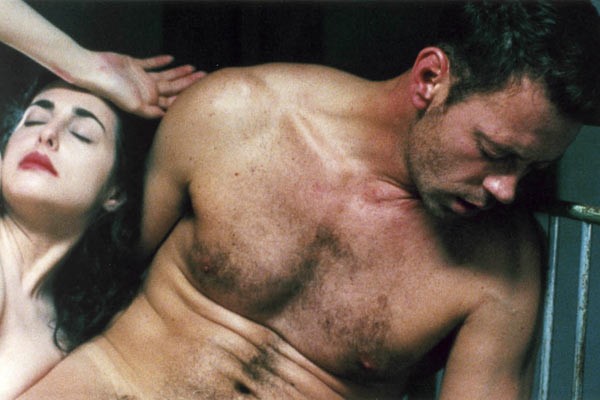
Amira Casar & Rocco Siffredi
Breillat’s strategy of forcing us to examine forbidden subjects makes us confront our inhibitions and deal with personal issues regarding our own bodies, or the bodies of the other. By deliberately seeking to nurture the spectator’s feelings of discomfort, the filmmaker can be seen to be working within the ideas that Mulvey espouses in “Visual Pleasure and Narrative Cinema.” Not just in terms of the “destruction of pleasure,” but also in relation to the use of psychoanalysis to deconstruct the way that women are constructed as objects in traditional Hollywood films. Mulvey makes the claim that “woman’s desire is subjected to her image as bearer of the bleeding wound, she can exist only in relation to castration and cannot transcend it.” 6 Breillat seizes this particular image and uses it at several key points in the film.
Anatomie de l’enfer ’s graphic scenes involving menstruation seem to correspond most literally with Mulvey’s assertion, but they also challenge some of the ideas that Mulvey uses to present her case. In particular, Breillat is critical of Freud’s conclusions regarding castration anxiety. This is supported by an interview featured on the DVD release of the film in which Breillat ponders whether psychoanalysis may just have it all wrong. In the interview, she stresses that it is not necessarily castration anxiety that causes men to fear the other, and counters with the idea that we should consider the possibility that man suffers from a jealousy of the uterus.
The fact that men are not able to create life, that they can only give death, is a concept that the film addresses in a very direct way. Breillat points towards the idea that this anatomical inability leaves men with an unquenchable desire to possess and to control. It is in regards to these thoughts that we will examine the depiction of menstrual intercourse within the film. The scene in question serves to present the Woman as the fountain from which life springs, while simultaneously showing that the Man’s adverse reaction is not simply him recoiling at the image of the phallus coated in blood. In the aftermath of that moment of coitus, we see the Man lying on the bed, his crotch painted red with menstrual fluid. As he ponders the sight, she asks how he responds if he finds himself soiled with feces during anal intercourse with another man. He explains how that situation is a different one altogether. “Fecal matter is inert,” he explains. His disgust is thus exposed, not as a fear of being soiled, but as something else entirely. It would be easy to believe that he sees his penis covered with blood and immediately associates the sight with castration, but it’s much deeper than that. It is a painful reminder of his inadequacy. It forces him to confront the sort of fertility he cannot possess.
The Man’s revulsion to this most natural occurrence is representative of attitudes towards menstruation that have existed for thousands of years. The book of Leviticus deems a woman to be unclean during the time of her flow, 7 and even goes so far as to insist that they should be separated from others for a period of seven days and be required to make a sin offering upon their return. Julia Kristeva, in Powers of Horror , devotes a fair amount of space to discussions of biblical abjection, and indeed includes the female body in the third major category of abomination. 8
Turning to the Bible itself for illumination, we can see that Leviticus clearly states that “if a man lies with a woman during her monthly period and has sexual relations with her, he has exposed the source of her flow, and she has also uncovered it. Both of them must be cut off from their people.” 9 When the Woman tells him about these restrictions at the beginning of the third night, it is a revealing moment. Her words expose the prejudices that society has, and in turn inform us of the bizarre way that people can perceive something that is completely natural as a sort of contagious impurity.
With a bloodied tampon in her hand, the Woman relates the irrational fears that men have of “this blood that flows without the need of a wound.” She then casually places the object in a glass of water, and allows the water to absorb the blood before offering it to her guest. This action demands that the Man confront his fear of this impurity, and the Woman explains the significance of the act by serving up the explanation that in ancient times warriors would drink the blood of their enemies.
Are the two characters really enemies, though? While there is certainly some degree of tension between the two, their relationship is more complicated than one based solely on animosity. In searching out research that would provide some indication of how to interpret the relationship that the protagonists of Anatomie de l’enfer have, one invariably arrives at Gaylyn Studlar’s exhaustive examination of the masochist aesthetic in the films of Josef von Sternberg starring Marlene Dietrich. 10 In this book, Studlar careful studies the way that sexual obsessions, involving varying degrees of humiliation, populate the narratives and determine the dynamic between the characters that Sternberg brings to the screen.
A substantial difference between the scenarios used by Sternberg and the one employed by Breillat is that she elects to employ a female masochist in Anatomie de l’enfer . This works in contrast to the figure Dietrich inhabits who, although on display for scopophilic purposes, is the object of desire for the masochistic male characters in Sternberg’s films. Studlar asserts that “as in Sacher-Masoch’s novels, the fantasizing masochistic subject is represented by a male character.” 11 To a degree, Breillat can be seen to be working from the opposite end of the spectrum. The Woman in Anatomie de l’enfer may be the submissive party, but she is definitely not passive. In fact, she is the one that initiates the contract with the Man.
The use of a contract is interesting, as it is a staple of the literary masochistic relationship, with roots that can be traced back to the works of Sacher-Masoch. In Coldness & Cruelty , Gilles Deleuze observes that “a contract is established between the hero and the woman, whereby at a precise point in time and for a determinate period she is given every right over him.” 12 In the case of Breillat’s film, the genders involved are reversed, but the goal is the same: “Through the contract, that is through the most rational and temporarily determinate act, the masochist reaches toward the most mythical and the most timeless realms.” 13
Within the context of the film, this contract obliges the Man to push the Woman towards ever greater moments of humiliation. This is a serious departure from the masochism at work in the films of Sternberg. While humiliation is involved, the primary source of “pleasure” for the male masochists is the emotional distress that they suffer. Anatomie de l’enfer , with its female masochist, takes a different route. The role play that makes up the bulk of the film does not involve the infliction of any physical or emotional pain. This is, in fact, characteristic of one of the differences between male and female masochism. Roy Baumeister’s statistical analysis of anonymous letters involving masochistic fantasies reveals that “the humiliation in female masochism emphasizes the woman’s femininity and sex appeal. The female masochist’s wish for spectators likewise makes her the center of attention and sexual desire since the role of a nonparticipating spectator, by definition, is to pay attention.” 14 If one allows that the film’s audience is the nonparticipating spectator, then one can easily see how this dynamic is very much reflected in the way that the relationship between protagonists functions within the film.
The passionless contract between the Woman and the Man also relates back to the idea of the abject. As observed by Kristeva, abjection “is immoral, sinister, scheming, and shady . . . a passion that uses the body for barter instead of inflaming it.” 15 At the core of the agreement in Anatomie de l’enfer is an exchange that is based on commerce, rather than lust. The dynamic between the characters certainly evolves over the course of the film, to the point where the dispassionate Man is manifestly unable to walk away from the experience unaffected. The voice-over narration as he leaves the house after the fourth night reveals the experience to be so affecting that he wishes he were able to refuse the money.
Studlar points out that “in masochism, the power plays of sexuality are made explicitly theatrical and ritualized so that their naturalness is exposed as a construct.” 16 The element of construction at work in Breillat’s film is made apparent before the film even really begins. The first thing presented to spectators of Anatomie de l’enfer is a notice informing them that a body double was used for the film’s most explicit sequences. This disclaimer also implores the audience to keep in mind that the film is a work of fiction. Breillat explains in the DVD interview that she deliberately selected someone for the inserts who was substantially hairier than Amira Casar, the actress playing the Woman, because those shots are not meant to show reality. They are designed to convey the perspective of the Man, who allows his own prejudices to interfere with what is actually happening in front of him, and thus the inserts show things as being somewhat different than they actually are.
The differences between female and male masochism are significant in another way. In male masochism, there is typically some degree of feminization of the man, whereas Baumeister observes that “female masochism does not appear to involve escape from the gender-based aspects of self to the same extent that male masochism does.” 17 This clearly establishes that this behaviour “involves an exaggeration and caricature of the female stereotype, rather than the realistic preservation of the female role.” 18 What this really means is that the relationship depicted in the film embraces the Woman’s gender, rather than subverting it. Additionally, the fact that it is the Woman that sets the terms of the contract establishes her role as one that is essentially empowering. No matter how much humiliation she is subjected to, there is only the illusion of submission. Throughout the film, despite her submissiveness, she is the one that dictates the path their relationship follows and she is the one that is in control.
Like the Woman depicted in Anatomie de l’enfer , audience members pay a fee and enter into a contract. We knowingly agree to be pushed to our limits, and possibly beyond, and hopefully we come away from the film with a better awareness of what it is that disturbs us. The abjectification of the body does not result in a film that is manifestly abject; rather, it serves to expose those traditional attitudes that regard aspects of femininity as being shameful or forbidden are inherently wrong. The nature of the Woman is perfectly natural, and society’s fears regarding this are essentially baseless. Gender difference is acknowledged in the film, but in a way that allows us to understand that these differences are complementary and horizontal, rather than hierarchically vertical.
Filmography
Breillat, Catherine. Anatomie de l’enfer – 2004. Tartan Video – TVD2005
Notes
- Marguerite Duras. The Malady of Death. trans. Barbara Brey. New York: Grove/Atlantic, 1986. p.24. ↩
- Catherine Breillat. Corps amoureux; entretiens avec Claire Vassé. Paris: Denoël, 2006. p. 116. ↩
- Laura Mulvey. “Visual Pleasure and Narrative Cinema.” in Feminism and Film Theory. ed Constance Penley. p. 58. ↩
- Mulvey 59. ↩
- Alison Butler. Women’s Cinema: The Contested Screen . London: Wallflower Press, 2002. p. 7. ↩
- Mulvey 58. ↩
- Leviticus 15:19-30. ↩
- Julia Kristeva. Powers of Horror: An Essay on Abjection . Trans. Leon S. Roudiez. New York: Columbia UP, 1982. 93. ↩
- Leviticus 20:18 ↩
- Gaylyn Studlar, In the Realm of Pleasure : Von Sternberg, Dietrich, and the Masochistic Aesthetic . Chicago: University of Illinois Press, 1988. ↩
- Studlar 58. ↩
- Gilles Deleuze. Coldness and Cruelty . in Masochism . New York : Zone Books, 1989. p. 66. ↩
- Deleuze 66. ↩
- Roy F. Baumeister. “Gender Differences in Masochistic Scripts” The Journal of Sex Research , Vol. 25, No. 4 (Nov., 1988), p. 495. ↩
- Kristeva 4. ↩
- Studlar 52. ↩
- Baumeister 496. ↩
- Baumeister 496. ↩



